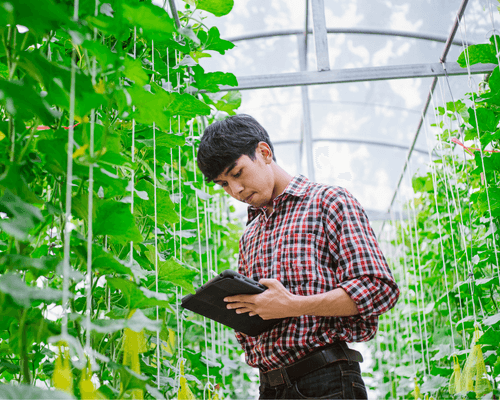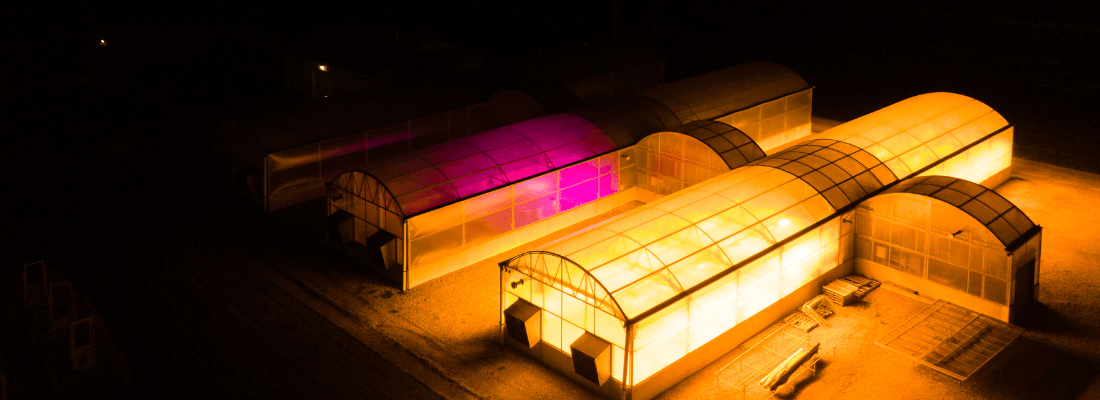Optimal Greenhouse Lighting with Grow Lights for Plants: Light and Plant Interaction
Light is crucial for greenhouse production, as it provides the energy for crops to perform photosynthesis: the process of converting light into chemical energy for plant growth and fruit forming. Understanding the topic light and plant is therefore crucial.
Using the right grow lights for plants, there will be a higher yield at the end of the season in Controlled Environment Agriculture (CEA). Also, knowing which types of plant grow light are the best to use, will help you to save energy costs in greenhouse lighting.
On this page, we will among others be discussing the importance of lighting for plant growth, background information on wavelength of light for plants, grow lights for plants (differences between HPS lights, led grow lights, full spectrum lighting), short day & long day plants, greenhouse lighting and reasons to install grow lights for indoor plants.
On this page, there will also be a special focus on the latest research outcomes of interlighting (Intra-canopy lighting): The new way of boosting plant yield in a greenhouse with LED grow lights between the leafs. The only thing that growers need to do, is to change the location where they place their (LED) grow lights.
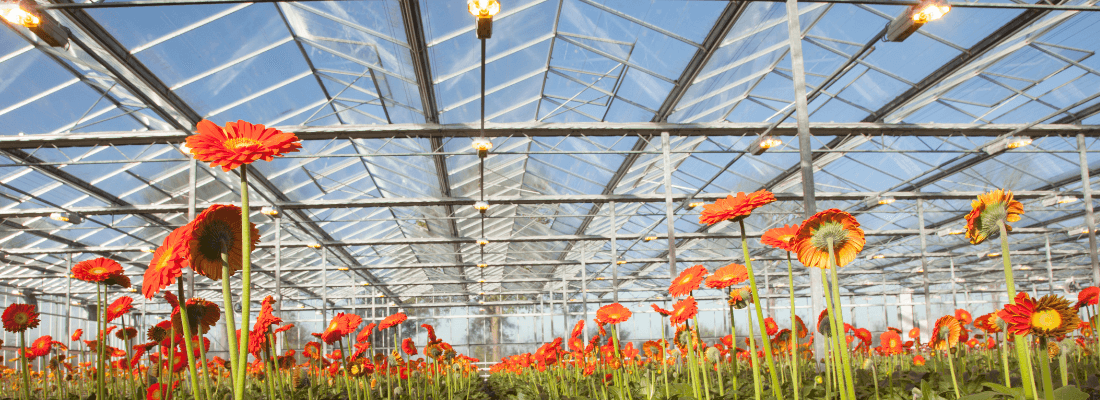
Table of contents:
- Table of contents:
- Importance of greenhouse lighting for plant growth
- Increase flavour and plant pigments with plant lighting
- Why supplemental lighting is used in greenhouses?
- Is using indoor greenhouse with light common?
- How greenhouse lighting is used for crop growth?
- Understanding Light Spectrum – Wavelengths for plant growth
- The interaction of Light and Plant
- Effect of Light on Plant Per Wavelength Range (nm)
- Using red light in greenhouses
- Effect of Blue light on plant growth
- Far-red light on plant growth
- Why do greenhouses use pink lights?
- Importance of choosing the right greenhouse grow lights for plants
- 6 Types of common Greenhouse Lighting
- 5 Benefits of using artificial light for plants in a greenhouse
- Grow lamps for Greenhouses – 2024 updates
- Grow lamps for Urban Greenhouses – 2024 updates on Vertical farming lights
- Explaining Efficiency and Efficacy of plant lights
- Intracanopy lighting
- Discover Dutch plant grow light and Dutch grow lamps
- Application examples of grow lights for vegetables and fruits in greenhouses
- Best Practices for Implementing Greenhouse Lighting
- FAQ about lights for greenhouse
Importance of greenhouse lighting for plant growth
Besides temperature, air humidity and CO₂ concentration in the greenhouse, light is a major environmental factor which affect the production in the greenhouse enormously.
Low light intensity and low amount of light is a major problem and limiting production factor in northern regions in the world, such as Canada and European countries like the Netherlands, Sweden and Finland where there is often not enough sunlight for optimal crop production.
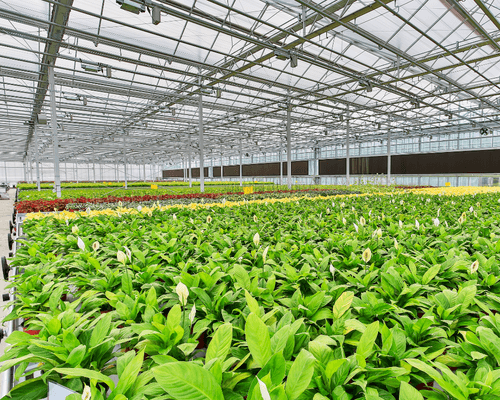
Indoor greenhouses with supplemental lighting produce more
To ensure year-round production and high product quality, greenhouse crops need supplemental lighting. Applying supplemental plant lighting throughout the day, including the morning and the afternoon/evening when the sun is below the horizon, will help boost greenhouse production.
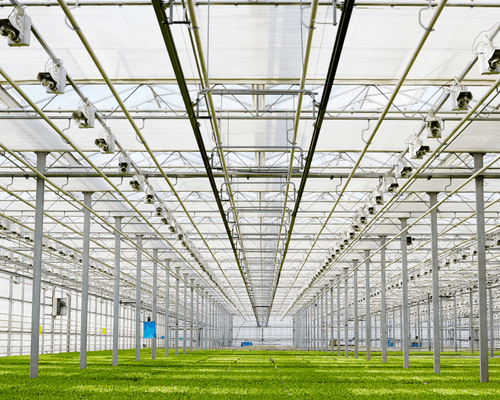
Not enough plant grow light will reduce yield
When there is not enough (or suboptimal amount of) sunlight, the yield will be low. Instead of big fruits (fully grown tomatoes), small fruits will be formed early in the season, which directly influences the level of yield.
Light is needed to drive photosynthesis, the mechanism that plants use to generate energy for growth. With too little light, plants won’t be able to grow and produce harvestable products to their full genetic potential.
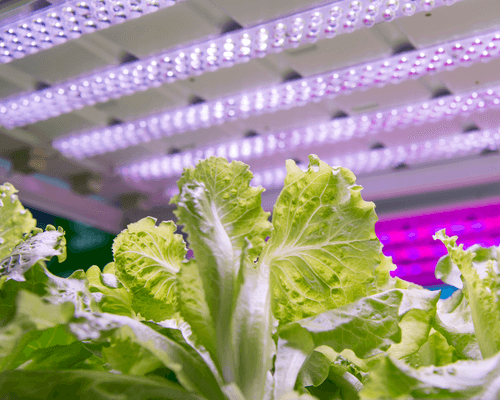
Increase flavour and plant pigments with plant lighting
Flavour of products is also associated with the amount of available light during the growing period. There are even research signs that poor flavour quality of some greenhouse crops is affected by low light intensity.
For strawberry and tomatoes, for example, the fruits will be sweeter and have a higher dry matter content if they are grown in full light compared to those growing in limited light conditions.
With the option to switch on the plant lights when needed in the greenhouse, the growing environment can be more precisely controlled, resulting in the cultivation of higher-quality plants
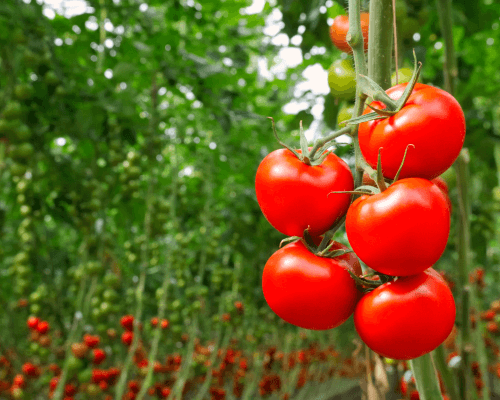
Why supplemental lighting is used in greenhouses?
Supplemental lighting is used in greenhouses to promote plant growth, as sunlight throughout the day might not be enough to create an optimal growing environment for the crops.
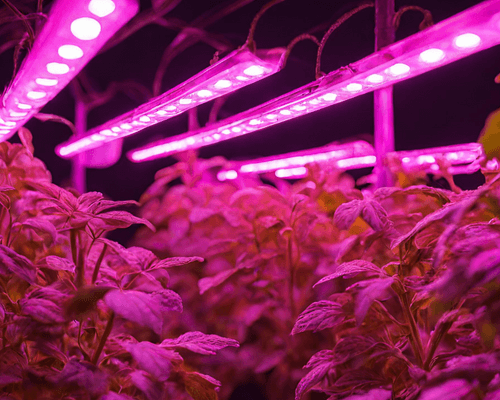
As long as the correct light spectrum is used, artificial lighting triggers the photoreceptors in the leaves in the same way as sunlight to drive photosynthesis.
In vertical farming, no sunlight is being used to produce crops such as lettuce, kale, and tomatoes. The plants depend entirely on supplemental lighting in vertical farms. Please note that this is a very energy-consuming way to grow crops.
Combining full spectrum sunlight with supplemental plant lighting
A more energy-sustainable way to produce food involves incorporating sunlight (considered as full-spectrum light) during production and supplementing it with additional artificial light using efficient plant grow lights with specific wavelengths.

Measurements have shown that inside a greenhouse, the amount of sunlight entering is often 40-50% lower than the outside environment. This reduction occurs due to reflection and absorption of light (photons) by the greenhouse infrastructure and glazing.
The structure of greenhouses blocks light from entering
To avoid high solar radiation during the summer period, shading materials are typically used on the roofs. These greenhouse energy covers / energy curtains are also used to keep the warmth inside the greenhouse (they prevent heat from escaping the greenhouse and a large drop of temperature during the nights).
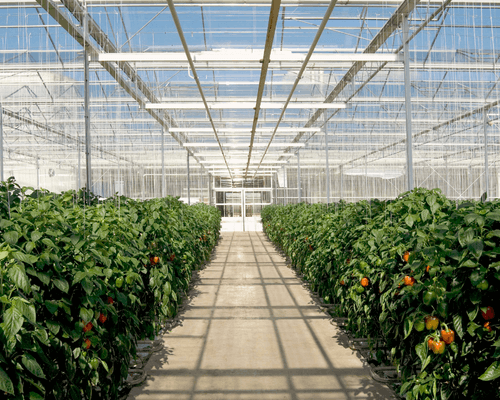
However, these things can even further reduce the amount of sunlight entering the greenhouse by another 40-80%. In the summer this is not a problem, because there is an excess of light. In the darker months of the year, this certainly will limit the production if no additional plant lighting is used.
Is using indoor greenhouse with light common?
Indoor greenhouse with light is very common. It has been estimated that in the Netherlands, about 2150 ha of glass greenhouses use supplemental lighting for propagation and production purposes.

Artificial light for plants is widely used in the Netherlands, where plant production needs to be kept high; otherwise, the greenhouse business won’t be profitable for the growers.
How greenhouse lighting is used for crop growth?
Besides using the energy of light to drive photosynthesis, plants need light to regulate their internal metabolism, development, direction of growth and creation of certain compounds.

For many greenhouse crops, there is a linear relationship between the amount of light intercepted by the leafs and dry mass (plant biomass) production.
In fruit vegetable crops (such as tomatoes and cucumber), 1% additional light results in an increase of 0.7-1% in harvestable yield! Supplemental lighting in greenhouses is therefore unmissable in many situations.
Understanding Light Spectrum – Wavelengths for plant growth
Understanding the light spectrum and wavelengths is crucial for optimizing plant growth. Using the right wavelengths promote plant growth and development.
Photosynthetically Active Radiation (PAR)
To drive photosynthesis, only certain wavelengths of light are used. Plants have pigments that can absorb wavelengths of the “photosynthetically active radiation”(PAR) spectrum, which are 400-700 nm (nano meters).
PAR is the part of the radiation from the sun or artificial lighting (in this case plant grow lights) that the plant can really use for photosynthesis.
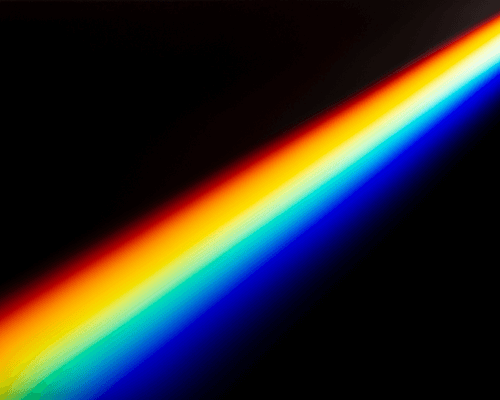
Energy of light wavelengths matters
This light spectrum of 400-700 nm, nearly corresponds with the spectrum that we can see with our human eyes (380 to 700 nm). This spectrum is also called the visible light spectrum. The light at 400 nm can be described as violet and at 700 nm “far red”.
A photon (which can be explained as a light particle which carries a certain amount of energy) of a shorter wavelength than 400 nm (such as UV light), carries too much energy for the plant to be able to use it for photosynthesis.
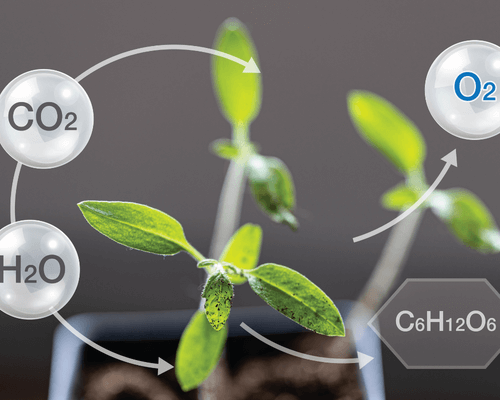
A surplus of energy carried by a photon can damage cells and plant tissues. Most of the high energy photons found in sunlight are filtered out by our atmosphere.
Photons at longer wavelengths (>700 nm) do not participate in driving photosynthesis in plants, because they do not carry enough energy to allow photosynthesis to take place. A rule of thumb: the longer a wavelength, the less energy it has.
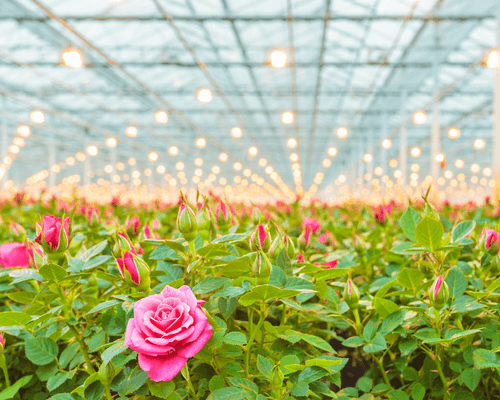
Measuring light for plants
The PAR light can be measured in W/m2 (energy of the total radiation) or in µmol/m2/s. Often, in horticulture, µmol/m2/s is more often used. Because this value tells you the amount of light received, by plants. 1 mol = 6.03*10^23 photons.
A major advantage of using µmol/m²/s, is that it provides a standardized and consistent way to measure light intensity, regardless of the specific wavelengths (colours) of light being considered.
1% more light = 1% more yield
Besides using the energy of light to drive photosynthesis, plants need light to regulate their internal metabolism, development, direction of growth and creation of certain compounds.
For many greenhouse crops, there is a linear relationship between the amount of light intercepted by the leafs and dry mass (plant biomass) production.
In fruit vegetable crops (such as tomatoes and cucumber), 1% additional light results in an increase of 0.7-1% in harvestable yield! Supplemental lighting in greenhouses is therefore unmissable in many situations.
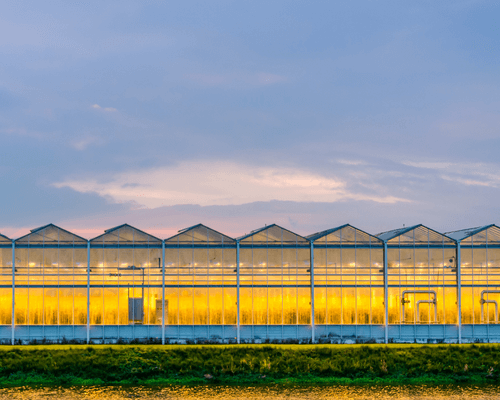
The interaction of Light and Plant
The interaction between light and plants is an important aspect of plant biology, because it shapes the growth, development, and overall life cycle of plants.

Grow light on the leaf surface
Plant light is absorbed, reflected or transmitted when the light reaches the plant. Some of the absorbed light is converted into chemical energy, which can be used to drive photosynthesis. Remaining energy is either released as heat or fluoresced.
Here below, some parts of light and plant interaction are mentioned:
Light is used as:
- Energy source for photosynthesis
- Environmental signal that plants use to assess their surroundings
Light changes:
- Leaf angle (leaf orientation)
- Stem elongation
- Degree of stomata opening in leafs
Light controls:
- Internal biological clock of plants (circadian rhythms)
Effect of Light on Plant Per Wavelength Range (nm)
Different wavelengths of light have different effects on the plant.
Based on the research results of Gupta and Jatothu (2013), Singh et al. (2015) and Tian et al. (2014), Ahmed and his colleagues (2020) have summarized the effect of light on plant development and growth per wavelength. Additional information on plant physiological effects per wavelength has been added to this table:
| Wavelength range (in nanometer) | Colour of light | Effect on plant |
|---|---|---|
| 280-400 (High energy) | Ultraviolet |
|
| 400-450 | Violet |
|
| 450-500 | Blue |
|
| 500-570 | Green |
|
| 570-590 | Yellow |
|
| 590-610 | Orange |
|
| 610-700 | Red |
|
| 700-750 | Far red |
|
| >750-1350 | Near infrared |
|
Using red light in greenhouses
The photons of red light typically have a wavelength between 610-760 nm. Red LED lamps emit red wavelengths at around 660 nm.
This is because this wavelength is very close to the absorption peak of the plant pigment chlorophyll.
Meaning, a plant can absorb this wavelength really well, to use it for photosynthesis.
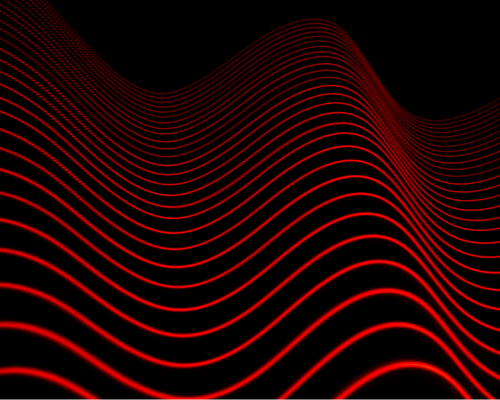
Mixed plant light colours needed for optimal plant growth!
Even though red light is very effective at driving photosynthesis, this light spectrum can not be used monotonously. For an optimal plant growth, blue light is needed too.
Red light for seed germination stimulation
Red light is also involved in the regulation of seed germination. Seeds exposed to red light often show higher germination rates. This is because the red light-absorbing form of the phytochrome photoreceptor (phytochrome Pr) is converted to the active form (phytochrome Pfr) under red light, triggering various responses, including germination and flowering.
The red light/far-red light ratio also plays a role in photoperiodic responses, which involve the measurement of day length. This information is crucial for plants to determine the time of year and adjust their growth patterns.
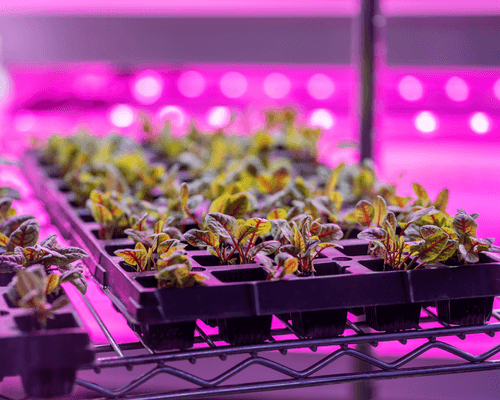
Producing green and healthy leafs with red light
Another very important function of red light on plants, is that it helps the plant to produce healthy and green leaves. This is because red-light is involved in the synthesis of chlorophyll, the green pigment responsible for capturing light during photosynthesis
Perfect horticulture light spectrum combination: red and blue
What is important to realize, is that red horticulture lights (supplemented by blue-rich LED lights) are widely used in greenhouses. Other colours (wavelengths) are only absorbed in a small amount by the plants.
It is more efficient to give the plants the exact spectrum their pigments can absorb than all the wavelengths. In this way, energy costs can be reduced too. Full spectrum LED grow lights costs more energy than LED grow lights of specific wavelengths.
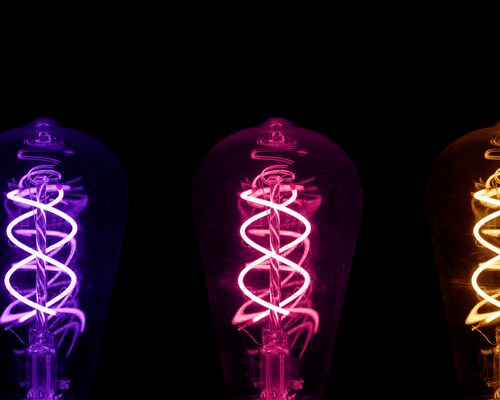
Effect of Blue light on plant growth
Blue light (450-500 nm) regulates stem extension and often inhibits stem elongation for a wide range of crops. The combination of both red and blue wavelength are necessary to produce crops without abnormal stem length.
Blue light affects gas exchange in plants
Blue light regulates the opening and closing of stomata, tiny pores on the surface of leaves. Stomata control gas exchange, allowing carbon dioxide to enter for photosynthesis and oxygen to exit.
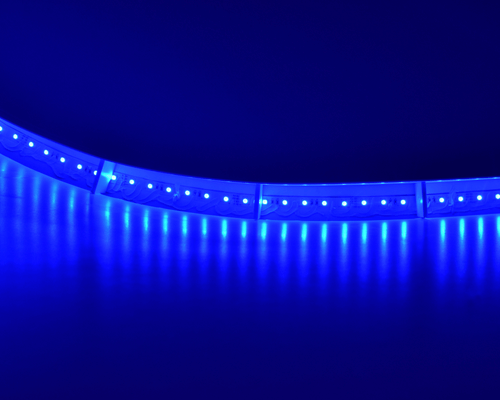
Blue light is needed to regulate metabolites in plants
Blue light has been associated with the regulation of secondary metabolite production in plants. These secondary metabolites include compounds such as flavonoids and alkaloids, which play roles in herbivore defence (resulting in the bitter taste of crops) and response to environmental stress, such as an excess of light (by producing more flavonoids/antioxidants).
Far-red light on plant growth
Changing plant growth patterns with far-red plant light
Applying far-red (around 700-800 nm) lighting can initiate earlier flowering in some long-day plants or promote continued growth in the vegetative state (and delay flowering for some species). Far-red light can also influence seed germination.
Currently, far red light is not being considered as Photosynthetic Active Radiation (PAR), because far red on its own doesn’t drive photosynthesis well. However, it has been found that applying far red together with other spectrum of PAR there is a significant increase in photosynthesis activity. This synergy is also called the Emerson Effect.
In the future, more growers might work with Extended Photosynthetically Active Radiation (ePAR).
Stem elongation with far-red light
Far-red light is also known to promote stem elongation, a phenomenon known as the “shade avoidance response”. In nature, when plants are shaded by neighbouring vegetation, the reduced ratio of red to far-red light signals competition, and plants respond by elongating their stems to reach for better light conditions.
Far-red light has been associated in the regulation of leaf expansion. It can affect the size and shape of leaves, changing the overall architecture of the plant.
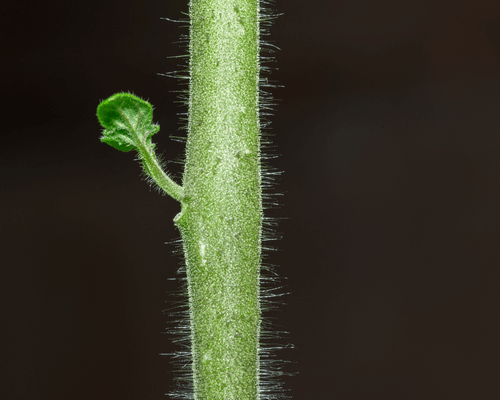
Including far-red light during production is important
While far-red light itself is less effective in driving photosynthesis compared to shorter wavelengths, it can still contribute to the overall light environment and influence the efficiency of photosynthesis indirectly by influencing plant morphology and structure.
Why do greenhouses use pink lights?
For a long time, we gave plants light in the greenhouses that were made for the human eyes, namely yellow greenish light and blue greenish light.
This because the installed lights in the greenhouses were also the lights we used in our homes, and our human eyes see things the best under these colours.

The reason why blue and red plant grow lights are used
The most abundant light absorbing pigments for photosynthesis in plants (chlorophyll) are sensitive to red and blue light (= they absorb red and blue light the best).
This insight and the development of more efficient and cheaper LED lights, led to the implementation of more red and blue LED grow lamps in greenhouses and indoor farming environments such as vertical farms.
Pink lights in greenhouses
When red and blue light are given together, we see this light as pink.
To answer the question why do greenhouses use pink lights, it is because this colour combination drives photosynthesis the most effectively and efficiently.
Some people consider this light combination also as purple.
Importance of choosing the right greenhouse grow lights for plants
Choosing the right greenhouse lighting is not only crucial for determining the success of plant growth and the eventual yield but also for the profitability of the greenhouse business.
While greenhouse lighting represents a major operational cost, it significantly contributes to yield improvement.
Below, we will provide 5 reasons and elaborate in detail on why choosing the right grow lights for plants from the outset is important:
1) Specific wavelength needed for Photosynthesis:
Not all types of lamps are suitable for efficient plant growth. Plants rely on the process of photosynthesis to convert light into energy, which can be used by the plants to grow. Different types of lights emit varying wavelengths of light. You need lights that have wavelengths that can be used by the plants to drive photosynthesis.
As explained above, plants can only use “photosynthetically active radiation”(PAR) (400-700 nm (nanometers) for photosynthesis. So, grow lamps that have wavelengths below 400 nm or above 700 nm, can not be used by plants for photosynthesis.

2) Energy Efficiency and Cost-effectiveness:
As grow lamps for crop production will be placed throughout the greenhouse, a considerable number of grow lamps need to be purchased. Because of this, selecting the right grow light from the very start is really important.
Additionally, factors such as energy efficiency and the long-term operational costs of plant lights need to be considered beforehand.
Moreover, energy-efficient lighting systems not only contribute to sustainable greenhouse practices but also help save costs over time.
By investing in high-quality, energy-efficient grow lights, greenhouse growers can strike a balance between providing optimal light for plants and minimizing operational expenses.
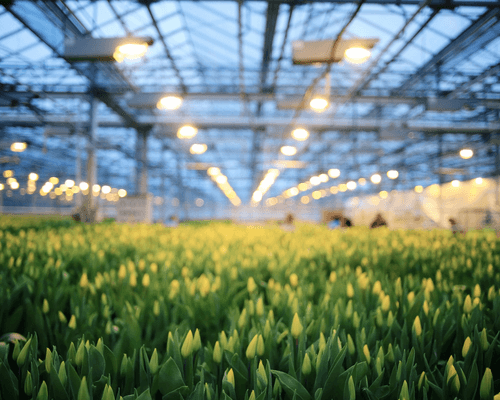
3) Choosing between dynamic lighting or fixed spectrum grow lamps
Different plants and different stages of plant growth require specific light conditions to flourish. For instance, young plants need a different light spectrum than mature plants that are going to flower soon.
Besides fixed spectrum LED lights, dynamic LED lights also exist, making it possible to change the spectrum of the lights when the grower needs to. By choosing grow lights with an adjustable wavelength spectrum (using dynamic grow lights), greenhouse growers can gain precise control over the growth cycles of their plants.
Using a “light recipe” (specific wave lengths) during the growing period, a grower can enhance and develop specific plant characteristics. This could be inducing red pigments in lettuce to enhance its nutritional value with blue light, branch development or stimulating flowering.
Because the spectrum is adjustable, growers can also use the lamps for different crops, providing flexibility for the grower to decide what should be grown in the following crop cycles based on market demand.
Dynamic lighting, however, is more expensive. Therefore, the decision to include dynamic lighting in the greenhouse depends on the potential added value per greenhouse.

4) Heat generating lamps needed or little heat as possible?
Even though more heat-generating lamps, such as High-Pressure Sodium Lamps (HPS lamps), are being replaced with non-heat-emitting lamps like LED lamps because they are more energy-efficient, it is worth considering the type of crop you are planning to grow before purchasing the lamps.
In some Nordic countries, such as Finland and Sweden, light that contributes up to 50% of the required heat in the greenhouse is not uncommon. In this situation, the heat-producing HPS lamps have dual functions.
Using LED lamps results in a lower ambient growing temperature in the greenhouse, so this aspect should be taken into consideration.
Another source of heat will need to be found if the high-heat-emission grow lights in these greenhouses in these regions are being replaced with less heat-emitting LED lamps.
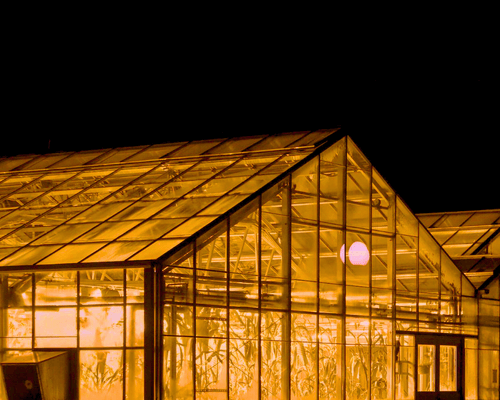
Flowers need their heat
Also, for some crops such as the gerbera flower, it has been found that these plants need the radiant heat of HPS lamps to grow optimally in the Netherlands. LED lamps do not generate enough heat for gerbera flowers.
Therefore, Dutch growers use red/blue LED lights in combination with HPS lights to compensate for the reduction in heat.
As grow lamps for crop production will be placed throughout the greenhouse, a considerable number of grow lamps need to be purchased. Because of this, selecting the right grow light from the very start is really important.
Additionally, factors such as energy efficiency and the long-term operational costs of plant lights need to be considered beforehand.
Moreover, energy-efficient lighting systems not only contribute to sustainable greenhouse practices but also help save costs over time.
By investing in high-quality, energy-efficient grow lights, greenhouse growers can strike a balance between providing optimal light for plants and minimizing operational expenses.
5) Minimizing Environmental Impact:
Choosing energy-efficient, long-lasting grow lights will not only reduce the carbon footprint associated with greenhouse operations but will also contribute to a greener cultivation operation.
Using efficient grow lights helps reduce the energy costs of the greenhouse and diminishes the environmental impact at the same time. Choosing LED grow lights contributes to long-term greenhouse sustainability.
6 Types of common Greenhouse Lighting
1) Natural Illumination with sunlight:
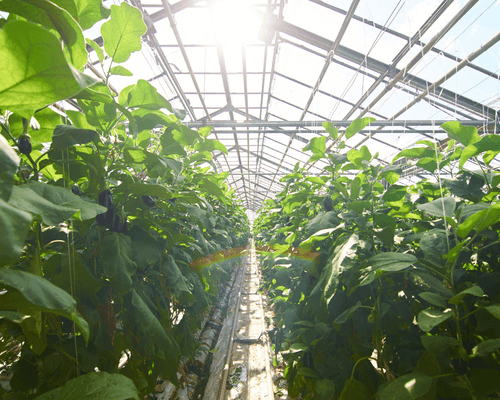
Sunlight is the best light source for crop production, as it not only provides a broad spectrum of light essential for plant growth (full spectrum lighting), it is also free.
However, sunlight is not always available in the right amount for crops due to limiting weather conditions (clouds).
About 50% of the light energy from sunlight can be used by plants to drive photosynthesis (the ‘photosynthetically active radiation’).
Because the crops are grown under a certain protective cover (either glass or plastic greenhouse), the cover and construction materials reduce a certain amount of available radiation in the greenhouse.
Overall, the cover and construction materials prevent 20-45% of light from entering the greenhouse, depending on the type of greenhouse.
In the most advanced greenhouses, the structure ‘only blocks 20% of light,’ while plastic greenhouses block up to 45% of light. In the least beneficial situation (plastic greenhouses), the amount of light that can enter a greenhouse and be used by plants is only 23% (0.5 * 0.45 = 0.23).
Advantages of using sunlight in greenhouses:
- Full spectrum of light.
- Cost-effective (it’s free).
- Supports overall plant health.
Disadvantages of using sunlight in greenhouses:
- Limited control over intensity and duration.
- Relies on weather conditions.
- Availability depends on season
2) High-Pressure Sodium (HPS) Lights:
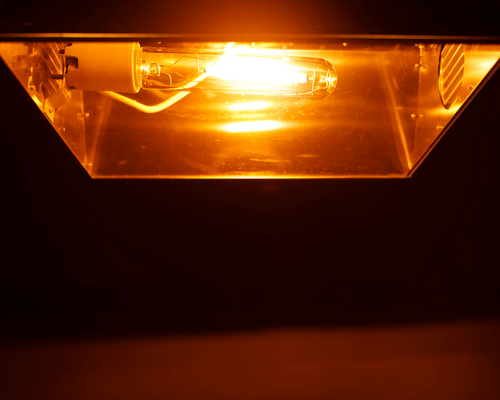
High-Pressure Sodium (HPS) lamps are a widely used type of grow lamp in greenhouses worldwide. They emit a warm spectrum that consists of yellowish-orange colored light, with just a bit of blue light.
HPS lamps are less efficient compared to LED lights, as a large amount of energy is converted into heat (due to infra-red radiation), actively heating up the greenhouse.
In cold climates, the generated heat of HPS lamps can provide up to 41% of the heat needed for optimal greenhouse production. In this case, HPS lamps are used for both light and heat generation.
In warmer climates, this heat is unfavourable and redundant, as keeping the greenhouse cool is already a significant challenge in hot countries.
A major downside of HPS lamps is that they need to be installed as high as possible in the greenhouse; otherwise, the generated heat will damage the plant. This reduces the efficiency of the lights for crop production. Additionally, HPS lamps use a lot of energy and have only a short life cycle (up to 16,000 hours)
Advantages:
- Lights are cheaper to purchase
- Able to heat up greenhouses (dual purpose grow light)
- Easy to use
Disadvantages
- Limited spectrum
- Generates heat
- Leaf damage if lamps are not installed high enough
- Low life cycle
- High energy usage
3) Metal Halide Lamps :
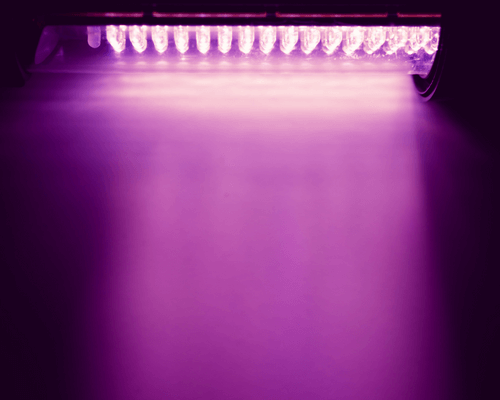
Metal halide lamps are known for producing a bright, white light that closely resembles natural sunlight.
Metal halide lamps are a type of high-intensity discharge (HID) lamp that produces light by passing an electric current through a mix of gaseous metal halides (compounds of metals with bromine or iodine).
When the lamp is energized, an electric arc is formed within the tube, causing the metal halides to emit light.
Before the introduction of LED lights, metal halide lamps were often used to supplement natural sunlight or provide light during periods of low sunlight, such as in winter or on cloudy days. They emit a broad spectrum of light that includes wavelengths important for photosynthesis.
A problem of metal halide lamps, is that they operated at a high temperature. Also, metal halide lamps form hazard to the environment and plants because they emit a lot of UV radiation. A major limitation of metal halide lamps, is that they are not easily to switch on and off whenever you want. It takes time before they reach full illumination power.
Advantages:
- Balanced spectrum.
- Good for vegetative growth.
- Higher efficiency compared to some alternatives
Disadvantages:
- Less energy-efficient
- Generates heat
- Not easy to turn on and off in a short period of time
- Radiates UV
4) Light Emitting Diodes (LED) Grow Lights:
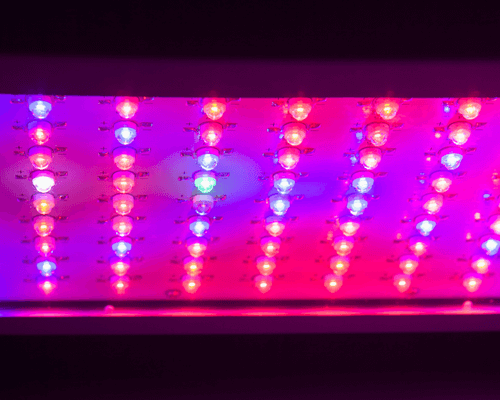
Light Emitting Diodes (LEDs) are a type of semiconductor diode that has gained popularity among commercial greenhouses in the past 10 years as LEDs have become more economically feasible to use.
LED growing lights are special because both the spectral composition and light intensity can be precisely controlled. This allows growers to tailor light conditions for different growth stages, helping them regulate plant morphological responses and trigger various physiological processes, such as flowering. Or to boost certain health-beneficial compounds in plants!
There are many other advantages associated with LED grow lights. The most important reasons for using LED growing lamps in greenhouses are energy efficiency, compact design, long lifespan (up to 50,000 hours), light quality, and low thermal energy generation.
However, compared to HPS lamps, LED grow lights are much more expensive to purchase. The higher capital costs to install an LED lighting system are one of the main reasons why some growers don’t choose LED growing lamps.
But when taking the annual electricity costs into account (LEDs use way less energy than HPS lamps) and considering their longer lifespan, it can be calculated that in the long term, LED growing lights will pay for themselves and are cheaper to use for greenhouse crop production.
Advantages:
- Energy-efficient
- Longer life span
- Customizable spectrum.
- Low heat emission (higher energy use efficiency)
- Flexible in switching on and off
Disadvantages:
- Higher initial purchasing costs
- Can not be used to heat up greenhouses
- Lower coverage area
5) Fluorescent Lights for Greenhouses:
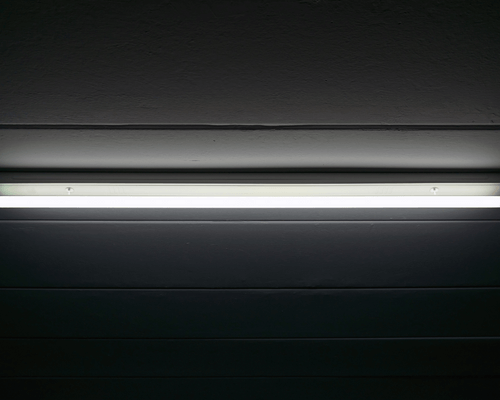
Before High-pressure sodium (HPS) lamps came on the market in the 1970s, fluorescent lights were mostly used for plant propagation. They were suitable for seedlings and young plants because of their lower light intensity.
General fluorescent lights will soon be banned in the US and the EU with the new rule that was accepted in 2023 by the EU to mitigate greenhouse gas emissions. These lamps might be harder to obtain in the future.
Fluorescent lights are to an extent energy-efficient but cannot provide enough energy during the vegetative and flowering stages of plant growth.
Fluorescent lights are not strong enough to penetrate deep down into the plant. Nowadays, fluorescent lights are mostly used in growth chambers.
Advantages:
- Suitable for seedlings
- Blue-ish light
Disadvantages:
- Reduced accessibility, due to new ban on fluorescent lighting.
- Lower light intensity.
- Limited to specific usages: propagation and germination
6) Hybrid Lighting Systems (⭐):

Hybrid systems combine different light sources to optimize the benefits of each technology. This approach aims to balance energy efficiency, light spectrum coverage, and heat generation.
A common hybrid lighting system involves combining LED grow lights with HPS lights. This can be done for two reasons: 1) to reduce the installation costs of new LEDs and 2) to compensate for the reduced heat production of LED lights.
For some crops that require heat, LEDs might not produce enough warmth in colder countries like the Netherlands during the winter. So the heat needs to come from an additional heat source.
Advantages:
- Customizable
- Optimal spectrum coverage
- More energy-efficient
- Combining advantages of two plant lighting systems
Disadvantages:
- Requires careful planning for optimal performance
5 Benefits of using artificial light for plants in a greenhouse
Below, we have summarized the five most important reasons why artificial lighting should be considered in a greenhouse.
1) Extended Growing Seasons:
Artificial lighting for plants in greenhouses makes it possible to extend the growing season beyond natural daylight hours. This is especially crucial in regions with shorter day lengths during certain seasons to maintain a day length of 12 hours or longer in greenhouses.
By providing additional light, growers can cultivate plants year-round without light limitations, maximizing productivity and profitability.

2) Increased Crop Yield (“1% extra light = 1% extra yield”):
Greenhouse supplemental lighting enhances photosynthesis, crucial for plant growth and development. A rule of thumb is that with an extra 1% light during the growth season, results in a 1% extra yield.
This boost in light energy leads to increased yields, faster growth rates, and improved overall crop quality. It is particularly beneficial for high-value crops where maximizing yield is a priority or in places where the highest possible yield per m2 must be achieved due to high operation costs.

3) Optimized Crop Production:
Optimized crop production through greenhouse lighting is achieved by providing plants with controlled and tailored light conditions. Especially with the introduction of easy-to-control LED grow lights, greenhouse growers can customize the light spectrum based on the specific needs of different crops and growth stages.

4) More Uniform Growth Across the Greenhouse:
Natural sunlight can be unevenly distributed within a greenhouse due to factors like shading, cloud cover, or the greenhouse structure itself. Artificial lighting helps overcome these challenges by providing uniform and consistent light coverage, resulting in more even growth across the entire greenhouse. This ensures that all plants receive adequate light for optimal development, leading to more similar fruit sizes throughout the growing season.
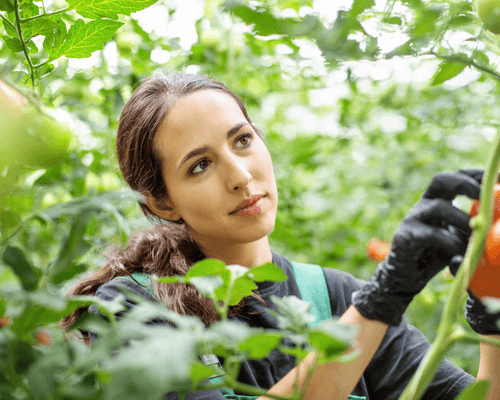
5) Grow any crop whenever you want:
Additional lights for plants throughout the season enable greenhouse growers to cultivate a wider range of crops, including those that may not have been able to grow in local environmental conditions or during specific seasons throughout the year. Some exotic crops could include growing vanilla in the Netherlands, wasabi in Iceland, and growing bitter gourd in the Netherlands.
Without indoor plant lights in Dutch greenhouses, producing this many tomatoes what we currently do throughout the year would not have been possible.
Due to our climate conditions, the outdoor production of this crop would have already ended by the conclusion of summer due to a lack of light and warmth. With grow lamps in the greenhouses, harvest can still occur during off-seasons of field crops, and growers can ask a higher price for their produce due to a lack of market availability.
This opens up opportunities for diversification and the cultivation of high-value speciality crops, meeting local and international market demands, and potentially increasing revenue streams.
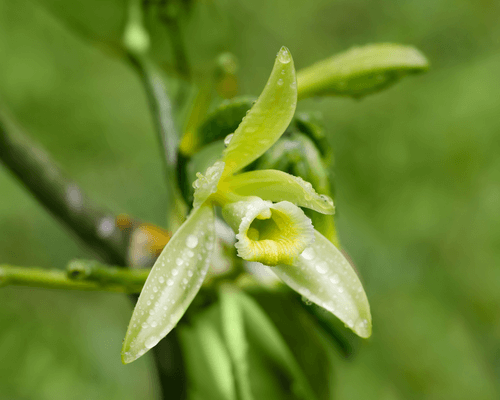
Grow lamps for Greenhouses – 2024 updates
Nowadays, when new high-tech greenhouses are designed and built around the world, LED (Light Emitting Diode) lights are often chosen as greenhouse lighting due to their long-term cost benefits and advantages for plant growth.
Existing greenhouses are gradually transitioning from High-Pressure Sodium (HPS) lights to LED lights when financial means become available as LED lights significantly use less energy and have a longer lifetime.
Installing LED lamps in new high-tech and mid-tech greenhouses has become a dominant trend. It is expected this will continue in 2024 and the following years
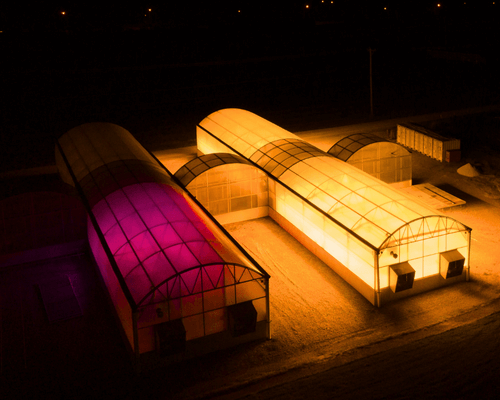
Grow lamps for Urban Greenhouses – 2024 updates on Vertical farming lights
Indoor vertical farms operate primarily with LED lighting systems, as they are the most energy efficient type of plant lamp.
This choice is particularly essential in vertical farms where plants are typically grown above each other. Keeping the heat emitted by the lamps as low as possible is crucial to prevent leaf burn and other plant damages.
Reducing energy usage by lights in a vertical farming is important for the existence of the farm, as it has been estimated that lights accounts for 70-80% of the electricity usage of a vertical farm. Using the right lights to cut back the energy usage is key..
Using efficient and dynamic LED lights, capable of changing wavelengths throughout the growing season will dominate in the vertical farm sector.

Explaining Efficiency and Efficacy of plant lights
In the context of plant lighting in greenhouses, the terms “efficiency” and “efficacy” are crucial factors to consider when evaluating the performance and cost-effectiveness of lighting systems.

Light Efficiency:
Definition of efficiency in greenhouse horticulture:
Efficiency refers to the ability of a lighting system to convert electrical energy into usable light energy. In the case of plant lights, the goal is to produce light that is most beneficial for plant growth while minimizing wasted energy in the form of heat.
Factors affecting efficiency:
- Energy conversion: High-efficiency lighting systems, such as LEDs, convert a significant portion of electrical energy into photosynthetically active radiation (PAR), which plants use for photosynthesis.
- Heat Emission: Less efficient lighting sources, like traditional High Pressure Sodium (HPS) lamps, produce a considerable amount of heat, leading to energy wastage and potentially requiring additional cooling systems in the greenhouse.

Importance in Greenhouse Lighting:
- High efficiency is critical for greenhouse operations to minimize energy costs and enhance sustainability.
- Efficient lighting systems contribute to a more controlled and stable growing environment by reducing heat stress on plants.
Light Efficacy:
Definition of efficacy in greenhouse horticulture:
Efficacy specifically measures the ability of a lighting system to produce light relevant to plant growth (–> photosynthetically active radiation), typically expressed in terms of photosynthetic photon flux (PPF), per unit of electrical power consumed.
Factors affecting efficacy:
- Light Spectrum: Efficacy is influenced by the light spectrum emitted by the lighting system. Plants have specific preferences for certain wavelengths of light, and efficacy accounts for how well a plant lighting system aligns with the spectrum that plants can use for photosynthesis.
Importance in Greenhouse Lighting:
- High efficacy is desirable, as it indicates that more usable light is being provided to the plants per unit of energy consumed.
- Efficacy values are essential for growers to compare different lighting technologies and make informed decisions based on the specific needs of their crops.
Intracanopy lighting
Currently, when lamps are installed in greenhouses, they are placed above the plants. A proven method to increase plant biomass production and boost the yield of harvestable fruits is to place LED lights between the leaves of plants. This placement of lights within the leaf canopy is also called intracanopy lighting.
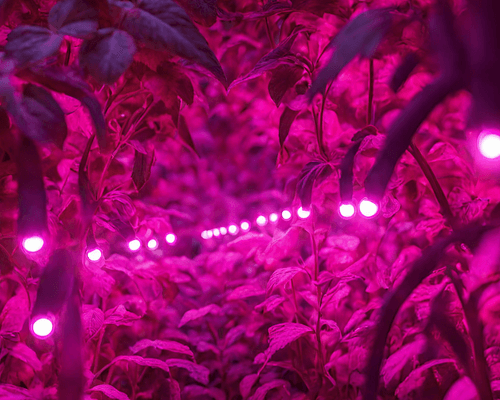
Preventing oversaturating of plant light with intracanopy lighting
An explanation for the higher yield when lights are placed between the leaves of a (vine) crop is that when the lower leaves receive more light, the total photosynthesis rate of the whole plant will increase significantly, thereby increasing the amount of plant biomass.
Usually, when lights are placed above the crops, the upper leaves will be saturated with light, but the lower and bottom leaves won’t. Due to shading, the lower leaves will only receive a fraction of the total light provided.
By giving the lower leaves more light, they can contribute more to photosynthesis than the saturated upper leaves. The upper leaves, saturated with light, won’t be able to drive photosynthesis further, as the maximum rate has already been achieved.
By placing lights between the rows, the lower leafs which are not saturated with light will benefit enormously from the extra light. Even when the total amount of energy is kept the same with the extra lights between the lights.
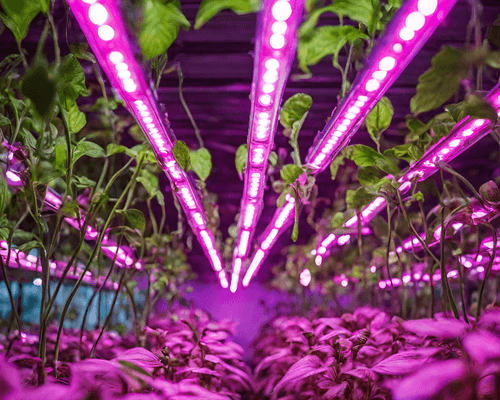
A recent study conducted in the Netherlands in 2023 has shown that tomato leaves intercepted 8% more light (higher total light absorption) when combining 50% intracanopy lighting with 50% top lighting with the same amount of applied light, compared to using only top lighting. This lighting strategy increased light absorption by 4%.
In another recent study in 2022, it was found that employing 67% top lighting with 33% intracanopy lighting, providing 375 micromoles of light/m², resulted in a 25% higher yield (harvested tomatoes in kg/m²) compared to using 100% 375 micromoles of light/m² top lighting.
Correctly placing lights in the right positions is, therefore, crucial. It is an easy and effective way to significantly increase the yield of harvested products when the initial financial means are available to purchase the grow lights.
Discover Dutch plant grow light and Dutch grow lamps
Dutch plant grow lights and grow lamps have gained international recognition for their innovation and effectiveness in supporting optimal plant growth.
The Netherlands, known for its advanced horticulture industry and (plant) light research, has played a significant role in developing technologies for greenhouse cultivation.

Dutch grow lamps are designed to provide the ideal spectrum and intensity of light necessary for photosynthesis, promoting healthy plant development and maximizing crop yields in greenhouses.
These lights are often engineered with energy efficiency in mind, aligning with sustainable and cost-effective practices.
The grow lights for indoor plants, such as LED and HPS (High-Pressure Sodium) lamps, are tailored to meet the specific needs of various crops in different growth stages.
With a strong focus on precision and performance, using Dutch plant grow light and grow lamps helps to succeed in production, both in the Netherlands and globally.
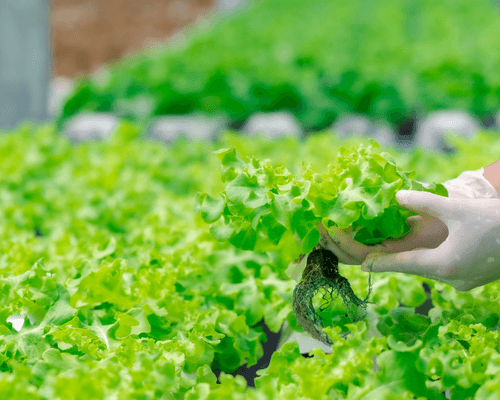
Application examples of grow lights for vegetables and fruits in greenhouses
Dutch horticulture lighting is widely utilized across a range of crops to enhance growth and increase yields in greenhouses. In regions with dark winters, supplemental lighting is needed to avoid high drops. The supplemental lighting makes it possible to produce crops in the winter. Some examples of crops and applications include:
Grow lights for tomatoes
Dutch horticulture lighting is extensively used in tomato cultivation, both in greenhouses and in vertical farming setups. The controlled light conditions contribute to increased yields and better-quality tomatoes!
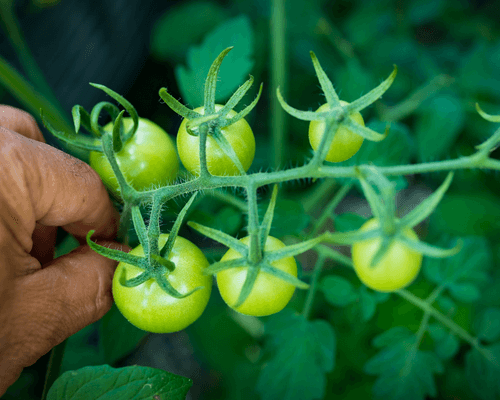
Grow lights for cucumbers
Similar to tomatoes, cucumber production benefits from horticulture lighting in greenhouses, ensuring consistent and optimized conditions for growth. Combining HPS lights and LED lamps in a greenhouse, have shown to be an effective and cost benefit way to illuminate cucumber plants while providing heating in the greenhouse. However, when LED lights become cheaper in the future, it is expected that less HPS lights will be used.
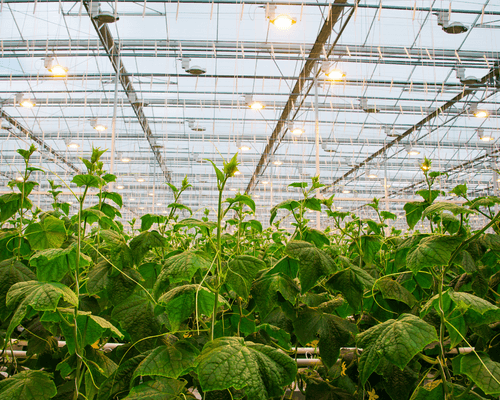
Grow lights for Medicinal cannabis
As medicinal cannabis is more being legalised in several countries and becoming a more important horticulture crop for medicinal purposes, an increasing amount of research is being done on assessing the effect of light on the production of Medicinal Cannabis Also, many commercial growers are trying out different ways to optimalise cannabis yield and tetrahydrocannabinol (THC) compounds by altering their light recipe and the light they are using.
It has been discovered that there is a positive linear relationship between light intensity and yield up to a light intensity of at least 1498 µmol m–2 s–1 .
In other words, up to 1490 µmol m–2 s–, doubling the light intensity also doubles the yield. This study has been done with LED grow lights for Cannabis.

Grow lights for bell Peppers:
The controlled environment provided by greenhouse lighting is valuable for bell pepper cultivation, allowing for year-round production (especially in the winter in the Netherlands and other higher latitude countries) with higher yields.
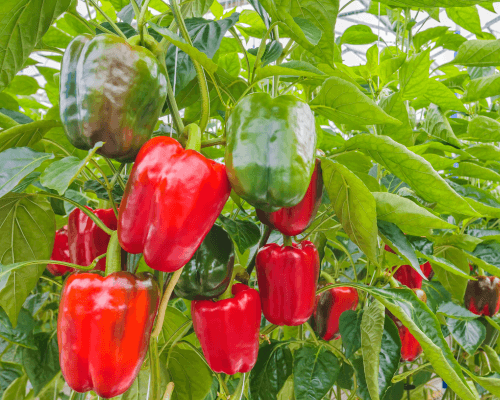
Grow lights for Lettuce and Leafy Greens:
In greenhouses and in vertical farms, lighting is used to cultivate lettuce, spinach, and other leafy greens more efficiently. The precise control of light conditions promotes rapid and uniform growth.
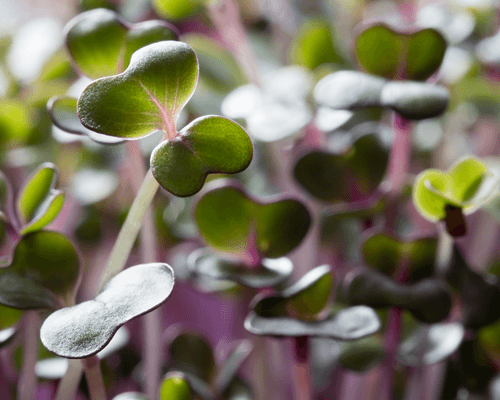
growing lights for Strawberries
Dutch growers use horticulture lighting to extend the growing season for strawberries, ensuring a more continuous and reliable supply. With growing lamps in greenhouses, not only spring, autumn but also winter strawberries can be cultivated in the Netherlands.

Grow lights for floral Crops:
Flowers such as roses and tulips benefit from horticulture lighting to regulate growth cycles, enhance colouration, and increase productivity. In Dutch greenhouses, the HPS lights provide heat for the roses to grow optimally in our ‘cold’ Dutch climate.
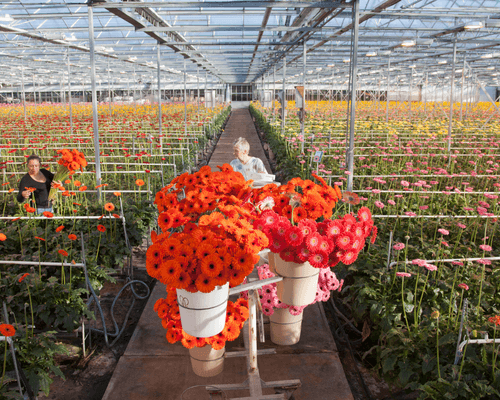
Grow lights for Herbs and microgreens in greenhouses:
Additional lighting is also used to grow herbs like basil, mint, and cilantro in greenhouses to maintain optimal growth conditions. Growers often forget that lighting also plays an important role in the flavour development of plants, especially for high quality herbs and microgreens. Microgreens are seedlings of edible vegetables and herbs and are characterized by their specific flavours.

Best Practices for Implementing Greenhouse Lighting
Implementing best practices for greenhouse lighting promotes uniform plant growth and optimizes light conditions for greenhouse crops.
Below, we have summarized some important factors to consider when installing greenhouse lighting. For efficient growth, remember to regularly monitor the conditions of plant lamps and use light sensors!
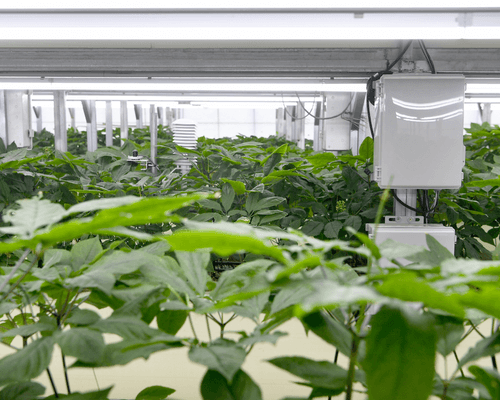
1) Optimal Light Placement:
Even Coverage of light:
- Strategically placing lights can ensure uniform light distribution across the entire greenhouse by. What to do: consider the light intensity required for the crops and then adjust the placement.
- Considering using reflective surfaces to enhance light usage. Using white walls and white floors can make sure that more light is absorbed by plants.
Avoiding shadowing and oversaturation
- By placing plant grow lights in a smart way, shading can be avoided as much as possible. When a combination of top lighting and inter-canopy lighting is used, shadowing effects can be reduced and more light will be available to the lower leafs in the plants. Which then can also contribute more to photosynthesis and drive the photosynthesis rate of the whole plant.

2. Lighting Duration and Intensity:
- Develop based on the greenhouse’s geographical location, seasonal variations, and specific characteristics of the crops, a suitable lighting strategy.
- Determine based on the type of crop being grown, a suitable photoperiod (light duration). Optimal day length is important to grow crops optimally. Too much or too little light will reduce the yield enormously, so managing lighting schedules is important.
- Consider providing plants (only) with more lights during critical growth stages or in low-light seasons to boost plant development. When done correctly, energy costs can be reduced enormously.
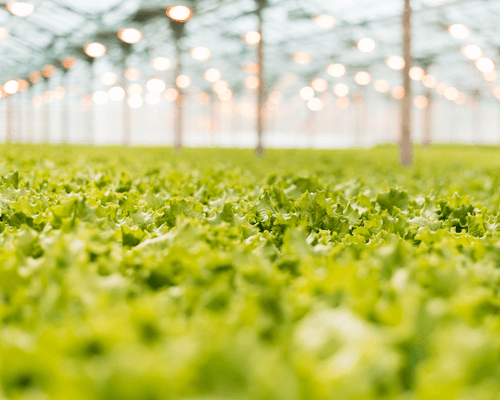
3. Monitoring & Maintenance:
Regular Monitoring:
- Implement a routine monitoring schedule to assess light levels throughout the greenhouse. Regular observations help identify potential issues such as declining light intensity of specific plant lamps or uneven coverage of the plants.
- Pro tip: Invest in light sensors and monitoring technology to track and record light levels accurately. Automated systems can provide real-time data and trigger adjustments based on pre-set parameters.
- Also: train staff to visually inspect plants for signs of inadequate lighting and recognizing broken plant lamps to prevent lack of light throughout the season!
